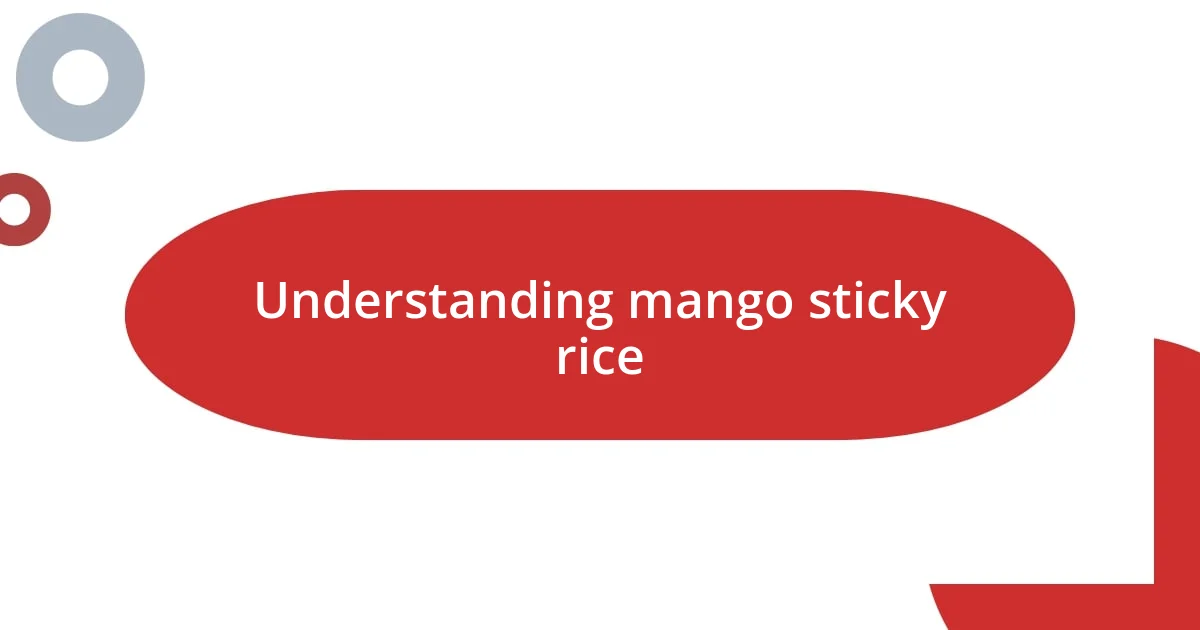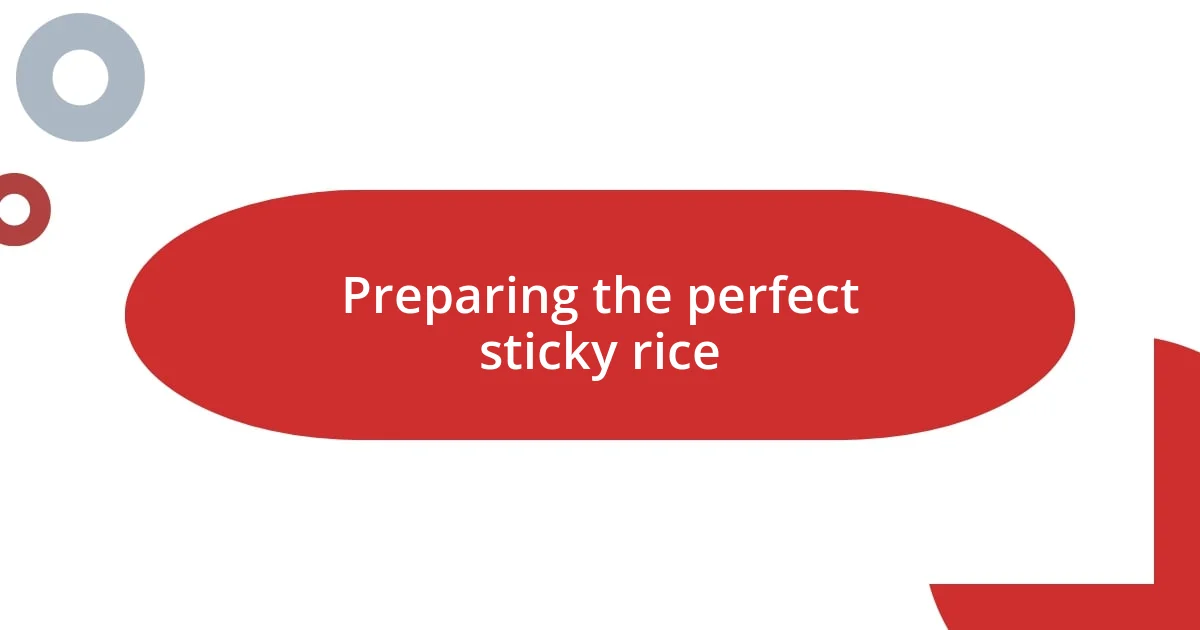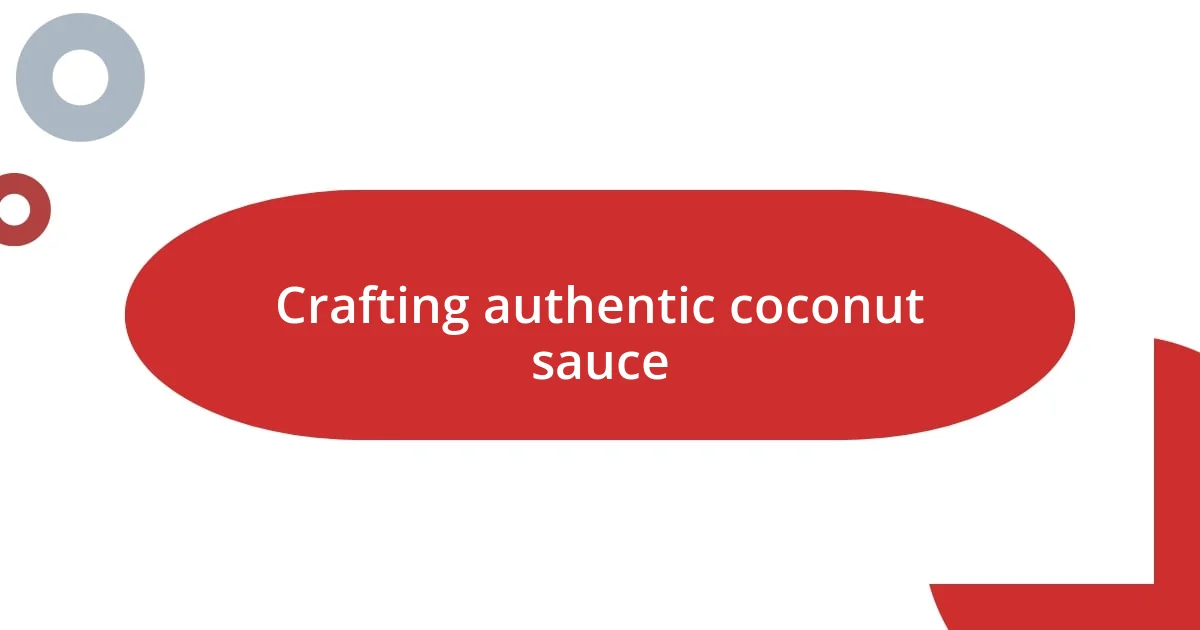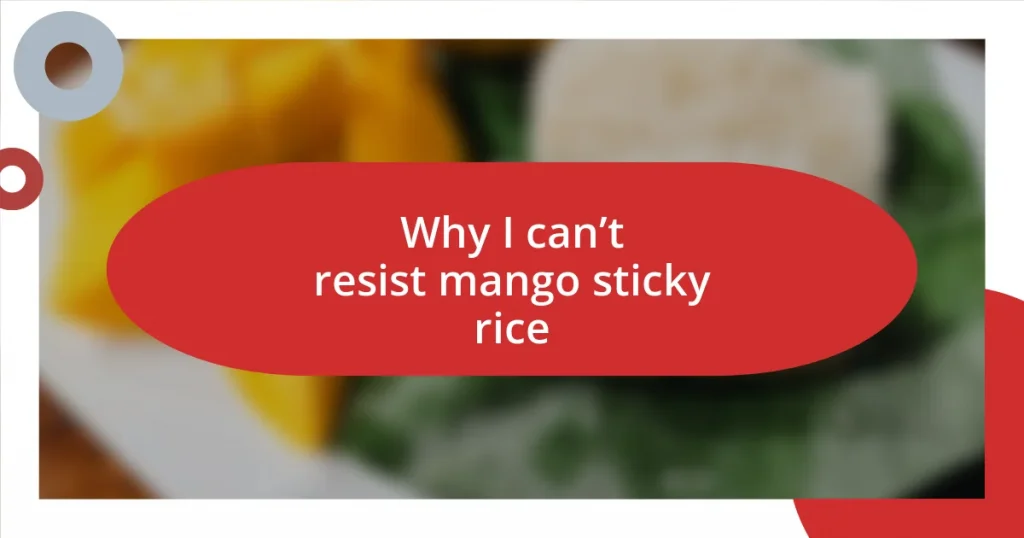Key takeaways:
- Mango sticky rice is a quintessential Southeast Asian dessert, known for its harmonious blend of sweet mango, creamy coconut milk, and chewy glutinous rice.
- Preparation is crucial; soaking the rice overnight and steaming it properly enhances its texture, while adding a pinch of salt to the coconut milk elevates the overall flavor.
- Choosing the right mango variety, such as Nam Dok Mai or Alfonso, is essential for achieving the perfect balance of sweetness and texture in the dish.

Understanding mango sticky rice
Mango sticky rice is a delightful dessert that originates from Southeast Asia, particularly Thailand. The first time I tasted it, the blend of sweet mango, creamy coconut milk, and the soft, chewy rice captivated my senses completely. Can you imagine that perfect moment when flavors harmonize so beautifully?
At its core, mango sticky rice consists of just a few ingredients, yet each plays a crucial role. The sticky rice, or “glutinous rice,” gets its name from its unique texture, which becomes even more delightful when paired with luscious mango. Whenever I savor a bowl, I can’t help but think of summer days spent at local markets, drawn in by the irresistible aroma wafting through the air.
One of the best parts is how customizable this dish can be. Sometimes, I like to sprinkle toasted mung beans or sesame seeds on top for a delightful crunch. Have you ever tried pairing it with a hint of salt in the coconut milk? That contrast elevates the entire experience, creating a balance between sweet and salty that leaves you wanting more.

Preparing the perfect sticky rice
Preparing sticky rice requires a delicate touch and a bit of patience. I remember my first attempt—let’s just say the sticky rice turned out more like a gluey mess than a delightful treat. The key lies in soaking the glutinous rice for at least four hours, ideally overnight. This really allows the grains to absorb water, ensuring that they cook evenly and become delectably chewy.
Cooking the rice is another critical step where precision counts. I often use a bamboo steamer; it gives the rice a fantastic texture. It might seem like just steaming at first, but the way the steam envelops the rice with gentle heat exfoliates the grains beautifully. After about 30-45 minutes, the rice should be soft yet still retain that signature chewiness. Don’t rush this process; the anticipation makes the final result even more rewarding!
Once the rice is cooked, I always find it essential to fluff it with a gentle touch before mixing in the coconut milk. This step creates a beautiful harmony between the rice and its creamy counterpart. I love how adding a pinch of salt to the coconut milk intensifies the sweetness of the sticky rice. It’s the little things that matter most in cooking, don’t you think? Those small tweaks transform a good dish into something truly special.
| Step | Description |
|---|---|
| Soaking | Soak glutinous rice for 4 hours or overnight before cooking. |
| Cooking | Steam the rice for 30-45 minutes until soft and chewy. |
| Final Touch | Fluff the rice and mix with salted coconut milk for flavor enhancement. |

Choosing the right mango variety
Choosing the right mango for mango sticky rice can truly elevate the dish. I’ve learned that the type of mango you select significantly impacts the final flavor and texture. When I discovered the difference between varieties, it was like a light bulb moment for me—the succulent sweetness of a perfectly ripe mango can turn a good dessert into an unforgettable experience.
Here are some varieties that I highly recommend for mango sticky rice:
- Nam Dok Mai: This Thai variety is my absolute favorite. It’s known for its sweetness and smooth texture, making it ideal for the dish.
- Ayutthaya: With a slightly firmer texture, Ayutthaya offers a refreshing tartness that complements the richness of the coconut milk.
- Haden: If you love a mango with a bold flavor, Haden’s sweet and aromatic profile is hard to resist. It adds a delightful contrast to the sticky rice.
- Alfonso: Often considered one of the best mangos globally, its creamy texture and sweetness infuse the dish with luxury.
When I first tried mango sticky rice with Nam Dok Mai, it was like I had discovered mango’s true potential! Each mouthful was a burst of creamy coconut and juicy mango bliss that felt like summer captured in a bowl. I encourage you to choose ripe mangos, as they not only enhance the dish aesthetically but also create that luscious, mouthwatering experience we all crave.

Crafting authentic coconut sauce
Crafting an authentic coconut sauce truly elevates the experience of enjoying mango sticky rice. I remember my first attempt at making the sauce—I was stunned by how simple yet profound the flavors could be. The secret is using fresh, full-fat coconut milk. It lays the groundwork for that deliciously creamy texture we crave. After all, who doesn’t love the rich, velvety mouthfeel of authentic coconut sauce?
To get the sauce just right, I often add a touch of sugar and a pinch of salt. It’s a beautiful balance! The sweetness brings out the natural flavors, while the salt enhances the dish’s overall profile. I’ve found that simmering the ingredients together creates a delightful aroma that fills the kitchen, making it hard to resist sneaking a taste before it’s even served. Have you noticed how the right blend of flavors brings everyone together?
One tip I’ve picked up over the years is to incorporate a dash of pandan extract or a sprinkle of toasted sesame seeds for added depth. I recall a dinner with friends where I decided to experiment, and that small change turned heads around the table. Suddenly, that familiar sauce transformed into something unforgettable. There’s an incredible joy in sharing flavors like that; it connects us to our roots and each other.















